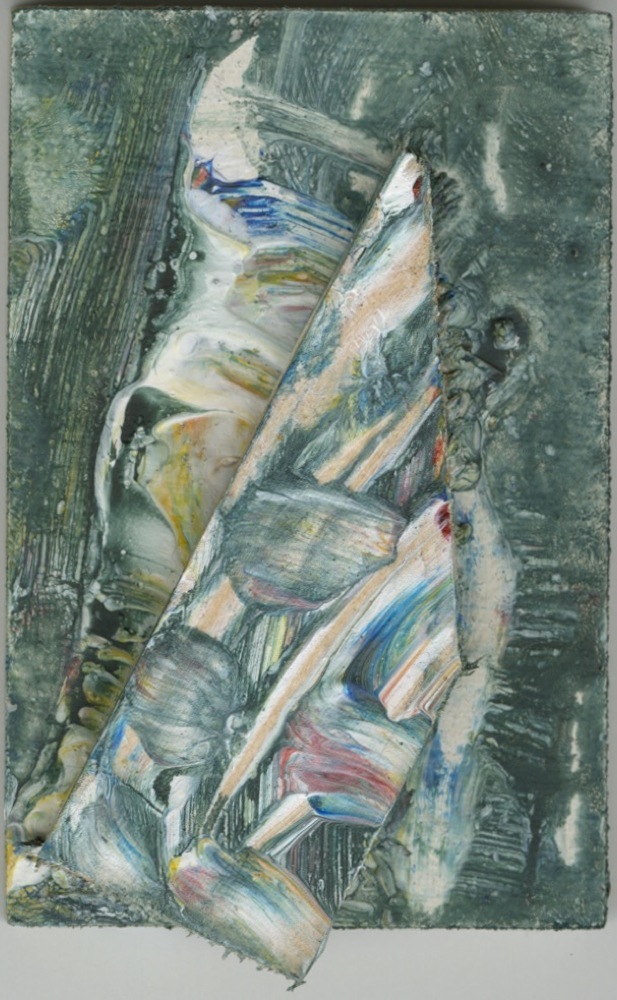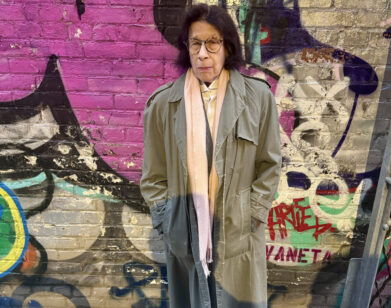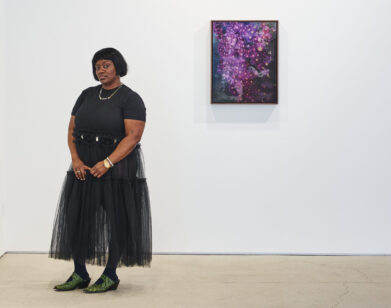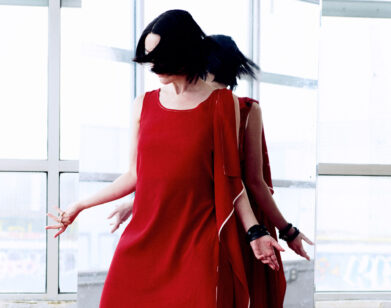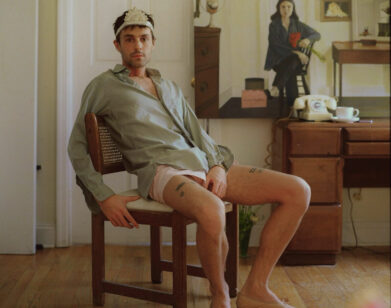Louise Fishman’s Abstract Activism
LOUISE FISHMAN IN NEW YORK, APRIL 2016. PORTRAITS: CHRISTIAN HÖGSTEDT.
We often want to create grand myths of artistic genius, of skill and deftness with paint, of sweeping aesthetic lineages and ruptures. As a painter and sculptor, Louise Fishman is certainly all of the above, but the artist has also found time to be an activist and educator committed to queer feminisms. In this way, the New York-based, Philadelphia-born artist is the embodiment of bohemia—a creative intellectual with a wide range of interests, one who knows how to think and how to love, how to diligently work and how to let loose. Fishman considers creativity essential to her activism; since the 1960s, she has surrounded herself with artists, writers, and academics in an effort to advance women’s and queer liberation at a time of social upheaval in New York. She is interested in consciousness-raising as a revolutionary act, and through this has helped many women find their voices. So although her characteristically large, abstract paintings do not point explicitly to politics, they are not mute. Rather, her artworks prompt us to think about the activist or political implications of abstraction, a medium largely considered apolitical; on her explosive, vibrating canvases we can almost see the roots of revolution.
Fishman is currently the subject of two large exhibitions: “Louise Fishman: A Retrospective” at the Neuberger Museum of Art acts as the 77-year-old’s first comprehensive show, while “Paper Louise Tiny Fishman Rock” at the Institute of Contemporary Art, Philadelphia displays an entirely different body of work, focusing on sketchbooks, smaller paintings and sculptures, and other rarely-seen items. We spoke with Fishman—who has exhibited around the world and is included in the permanent collections of renowned institutions like New York’s Metropolitan Museum of Art and The Jewish Museum—about her multifaceted interests as well as her aesthetic, personal, and intellectual inspirations.
WILLIAM J. SIMMONS: Your roots in activism and teaching are so interesting and really set you apart from other artists.
LOUISE FISHMAN: Richmond College [now College of Staten Island, CUNY] was my first college art teaching job, and I was teaching a course that was supposedly for lesbians. It was the first course that had the word “lesbian” in it anywhere in the world. It was called “Lesbians As Creative People,” a name given to it by the director of the program. It was a big deal for me, and I knew it was a horrible title for the class, but I did what I could. This would have been in 1973 or 1974. This program was set up by the City University system to do away with the radicals, so they shipped us out to Staten Island! There were Marxists and Maoists and every kind of socialist, and there was a lesbian contingent of which I was a part, but there was tremendous hostility toward us.
SIMMONS: Even in university women’s studies and queer theory departments, you can still see that in 2016—and in the art world especially. Gay men my age tend to perpetuate misogyny by thinking they’re immune to it. We think we can be “one of the girls” but still say “vaginas are gross!” all the time. The lesbians always get the short end of the stick.
FISHMAN: Certainly. Sexism is as profound as it ever was. Look at what Hillary Clinton is going through! I’ve seen it so many times and in so many permutations. It’s astounding. We changed some things. As Bertha Harris would have said, the lesbians are the movement, the radicals. We are the radicals. I believe she was right. It became clear that we were the vanguard.
SIMMONS: Going off of that, the way that feminism relates to the discourse on visual art these days remains complicated. Some artists deal with feminist themes, but no one considers their work beyond those themes. Conversely, you have canonized women artists whose gender or sexuality have been erased. Women always seem to have to choose to be purely feminist or purely formalist, and that’s limiting.
FISHMAN: My history is of making a decision, a decision at a certain point not to be involved with the feminist movement. In the 1970s, I was in a very traditional consciousness-raising group, and I was transformed by it. CR [the colloquial term for consciousness-raising] began with Fanshen—a process in China that was the starting point of consciousness-raising and the practical means by which the Revolution took place in China. Intellectuals would go to the countryside and talk to the people, giving them each a chance to speak equally about a chosen topic where no one would interrupt them. Once each person had spoken, a conclusion might be drawn that the once purely personal experience could now be understood as having political consequences. That’s how the people of China became radicalized, and that was the beginning of their Revolution. I initially learned about consciousness-raising when I was in Redstockings, which I didn’t care for because it was very straight, but, for me, consciousness-raising was the fat, meat, and bones of feminism.
Then I joined a group called Upper West Side Witch, which included women who were much more politically active and who understood a nuanced level of politics. Several of them came out, but the group ended, and people went various ways. I wanted to get involved with other artists, but there weren’t any in those groups—they were writers, anthropologists, and academics of all kinds. I thought, “I need a place for my work; I need to examine myself as an artist.” There were some groups in SoHo that were beginning to form in the late 1960s, which were filled with outspoken women who didn’t know dick about feminism, and, of course, were straight. With all this pontification, I realized that I had no place there. In one such group, I suggested that we all get in a big circle, giving each person the opportunity to talk about a subject in the style of traditional consciousness-raising. They all talked about what they wanted. I had nothing in common with these women. When it came to me, I said, “I am a lesbian, and I am a painter.” No one talked to me. There was total silence. It was hurtful because I cared so much about the cause.
Together with the artist Patsy Norvell I founded a group for women, mostly artists, with whom I connected, and I introduced consciousness-raising to them. It included Patsy Norvell, Harmony Hammond, Elizabeth Weatherford, Sarah Draney, and Jenny Snider. After about four years, we all went our separate ways. Then I then set off on my own and showed every couple of years at Nancy Hoffman Gallery, who gave me my first solo show, then briefly at Mary Boone, and in a few other venues. However, it has always been a problem for my career that I am one, queer, two, a woman, and three, doing plain old abstract paintings. There’s not the subject matter that you see in other lesbian work—subject matter makes things more accessible and easy to write about. Abstract painting is not easy to write about. However, being outside of the system allowed me to separate myself from everything out there, and to develop how I wanted to. I watched a lot of young artists have big shows and big careers, and then the work just petered out. I was also aware at a very early age—in the 1950s, being in art school and seeing shows in New York and Philadelphia—that there were quite a few artists who became well-known for a certain kind of work and then began to copy themselves. It was a weakness in what became their oeuvre. It was initially strong, but instead of growing, they repeated things. That’s been a mantra of mine, to never repeat myself. There are certain things that are part of me that I can’t help, but my vision and analysis as I’m working centers on making sure that what I’m doing is fresh, that each piece is unique. It’s hard. I’ll always have my hands and the tools that I use, but invention is integral to keeping the studio completely alive.
SIMMONS: Keeping things new is certainly difficult on both sides of the aisle. Abstract painting is indeed hard to write about, and sometimes what people rely on is thinking about influence—”this reminds me of de Kooning.” With your work, whenever I thought about what your paintings might “look like,” it never quite clicked for me. Where do influence and art history fit in for you, when you somehow create things that look so fresh?
FISHMAN: My first education in painting was from my mother’s magazines. She was a painter, and I would take material from her studio to read. I suddenly became very excited about the abstract expressionists because they were so physical, and it seemed to be such an athletic activity. I was a very serious athlete, as much as a woman could be in those days. I played four years of basketball and pitched fastball on the boys’ team. Sculpture and athleticism are part of my art history. So, the physicality of Abstract Expressionism was very profound. I would look at pictures in my mother’s magazines of Joan Mitchell, who looked like a tough woman, and I said, “Wow, a precedent!”
I’m very rooted in art history, and I had an extraordinary education in art history at the Tyler School of Fine Arts. I was there in 1957 and then a few years later. Dr. Herman S. Gundersheimer was an important influence for me. The course he taught started with early history of painting, and went only as far as Mannerism. I always go back to [Paul] Cézanne; I always go back to [Chaim] Soutine, but there’s a lot before that. I was stunned, for example, when I saw the Grunewald Altarpiece. I couldn’t believe that such a painting existed. There were also paintings in Philadelphia that were extraordinary, like Rogier Van der Weyden’s Crucifixion Diptych [also known as the Philadelphia Diptych]. I would spend hours looking at it, and all these other works in the Philadelphia Museum of Art. The original library at Tyler had giant folios with the most exquisite reproductions of Giotto. Titian, Giotto, Cézanne—those are my heroes. I keep a low profile, but I’m quite ambitious; I look to Donatello.
Are there women in that group? I don’t think so. There are certainly women whose work I look at a lot, like Judy Rifka, Dona Nelson, and Suzan Frecon, but there’s a lot that comes out of my studio that’s just me. Unlike a lot of artists, I’m not really part of an art community. I have tended to hang out with people who are writers. Ingrid [Nyeboe, Fishman’s partner] has a Ph.D. in theater and ran theater groups in downtown Manhattan. Similarly, when I came to New York, I accidentally stumbled upon an Yvonne Rainer dance performance. It was in a loft on Bowery, and I walked in and was blown away. I identified with her as an artist, and I thought, “I want to be a dancer!” There was something about how she took on the work, with a kind of asexual look, that I loved. It seemed like such an intellectual activity that she was involved with—the way each movement was analyzed and repeated. I’m interested in a world of ideas. I’m a reader, and poetry has always informed my paintings. I also did sculpture, and I have always considered myself a sculptor, but painting kept me painting. There is a lot of painting in my life, but there are lots of other things as well. I used to go to jazz bars in Philadelphia to sketch the musicians, and once I drew Thelonious Monk, and I remember the ash on his cigarette getting longer and longer until it dropped on the piano.
SIMMONS: So what was it, considering your deep relationship to figurative painting, that drew you toward abstraction?
FISHMAN: My favorite painting is Cézanne’s The Bather [1885], which is in MoMA’s collection. I’ve drawn it and painted it many times, and I can never take my eyes off it. I think it is one of the most profound of his paintings. It’s about the body. It’s about a stance. It’s also very sculptural. I think Cézanne is probably my teacher. Mondrian as well, but I would say Cézanne for his respect for the rectangle and the picture plane. Learning about their passion was the beginning of my painting career. Another influence was Philip Guston, but long before he became figurative. He was on a panel at Tyler with Marcel Duchamp when I was studying there. I also remember his cigarette ashes; he held it in such an elegant way. Guston said at this panel—I didn’t understand it then, but I understand it more and more—he said, “What I want to do in the studio is to paint everybody out of the studio—the critics, the historians, other painters—and then I try to paint myself out of the studio.” I wondered, what does that mean? It stayed with me because I was so curious. I knew that it was crucial for me.
“LOUISE FISHMAN: A RETROSPECTIVE” WILL BE ON VIEW AT THE NEUBERGER MUSEUM OF ART, PURCHASE COLLEGE, SUNY, THROUGH JULY 31, 2016. “PAPER LOUISE TINY FISHMAN ROCK” WILL BE ON VIEWA THE INSTITUTE OF CONTEMPORARY ART, PHILADELPHIA, THROUGH AUGUST 14, 2016.

